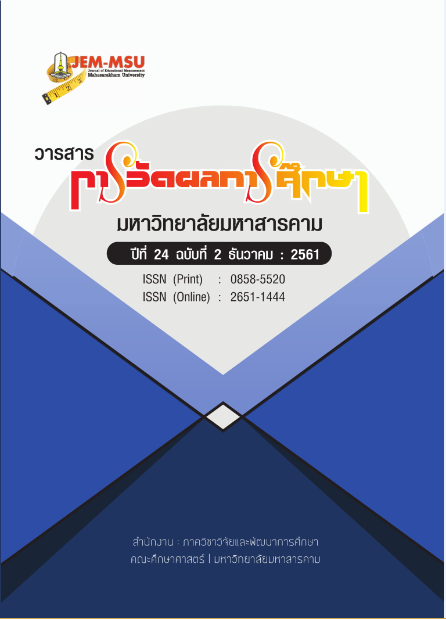Developing Learning Activities Contributing to Public Consciousness of The Thai Language Majors in the Faculty of Education, Mahasarakham University
Main Article Content
Abstract
The purposes of the study were 1) to develop learning activities that contribute to public consciousness of the Thai language majors in the Faculty of Education, Mahasarakham University, 2) to investigate the results of the learning activities on public consciousness of the Thai language majors in terms of metacognition, attitudes, and behaviors, and 3) to investigate satisfaction levels of the Thai language majors with the learning activities that contribute to public consciousness. The sample consisted of 77 second year Thai language majors in the Faculty of Education, Mahasarakham University, obtained through cluster random sampling. The instruments were: 4 organizing plans of learning activities contributing to public consciousness with the allotted time of 29 hours, a Likert scale evaluation form containing 30 items, and a Likert scale satisfaction evaluation form containing 20 items. The statistics used in data analysis were percentage, the mean, standard deviation, and t-test.
The results of the study were as follows: 1) the appropriateness of the learning activities developed to contribute to public consciousness of the Thai language majors in the Faculty of Education, Mahasarakham University was found at the highest level ( = 4.67). 2) The learning activities affected public consciousness of the sample positively on all aspects: metacognition, attitudes, and behaviors, with the detail given below: 2.1) The levels of public consciousness of the Thai language majors who had been through the learning activities that contributed to public consciousness on the aspects of metacognition, attitudes, and behaviors, before and after the experiment, as a whole and by aspect, were significantly different at the statistical level of .01 in both overall and aspect levels; 2.2) The evaluation of public consciousness of the Thai language majors according to the hands-on process revealed that every project passed the preset criterion of 80 percent. 2.3) The result of the authentic evaluation by observing the students’ behavior in participation in public consciousness activities was at the highest level (
=4.53); and 3) the overall satisfaction level of the students learning with the learning activities contributing to public consciousness was found at the highest level (
= 4.67).
Article Details
The content and information contained in the published article in the Journal of Educational Measurement Mahasarakham University represent the opinions and responsibilities of the authors directly. The editorial board of the journal is not necessarily in agreement with or responsible for any of the content.
The articles, data, content, images, etc. that have been published in the Journal of Educational Measurement Mahasarakham University are copyrighted by the journal. If any individual or organization wishes to reproduce or perform any actions involving the entirety or any part of the content, they must obtain written permission from the Journal of Educational Measurement Mahasarakham University.
References
มหาวิทยาลัย.
เกรียงศักดิ์ เจริญวงศ์ศักดิ์. (2556). แนวทางการสร้างจิตสาธารณะในสังคมไทย. รัฐสภาสาร. 61(1):
หน้า 77-79
ทิศนา แขมมณี. (2558). ถอดรหัสปรัชญาของเศรษฐกิจพอเพียงสู่การสอนกระบวนการคิด. กรุงเทพฯ :
สำนักพิมพ์แห่งจุฬาลงกรณ์มหาวิทยาลัย.
นงลักษณ์ เขียนงาม และสมพร เมธีวัฒนากุล. (2553). ปัจจัยที่เกี่ยวข้องกับจิตสาธารณะของนักศึกษา
มหาวิทยาลัย. วารสารมหาวิทยาลัยราชภัฏยะลา. 5(1) มกราคม-มิถุนายน,. หน้า 101-108
เบญจวรรณ รอดแก้ว. (2553). การพัฒนาจิตสาธารณะของนักศึกษามหาวิทยาลัยราชภัฏสกลนคร จากการ
ทำโครงการกิจกรรมพัฒนาสังคม. วารสารมหาวิทยาลัยราชภัฏสกลนคร. 2(3) มกราคม-
มิถุนายน, หน้า 79-91
วัลลยา ธรรมอภิบาล. (2555). การพัฒนาหลักสูตรเสริมสร้างจิตสาธารณะ สำหรับนิสิตระดับปริญญาตรี
มหาวิทยาลัยทักษิณ วิทยาเขตสงขลา. ปริญญานิพนธ์ดุษฎีบัณฑิต มหาวิทยาลัยศรีนครินทรวิโรฒ
ประสานมิตร.
สาขาวิชาภาษาไทย ภาควิชาหลักสูตรและการสอน. (2559). หลักสูตรการศึกษาบัณฑิต สาขาวิชาภาษาไทย
หลักสูตรปรับปรุง พ.ศ. 2559. อัดสำเนา.
สำนักงานคณะกรรมการการศึกษาแห่งชาติ. (2555). แผนการศึกษาแห่งชาติ (พ.ศ.2545-2559). กรุงเทพฯ :
บริษัทพริกหวานกราฟฟิค จำกัด.
อ้อมใจ วงษ์มณฑา. (2552). ปัจจัยที่ส่งผลต่อจิตสาธารณะของนักศึกษมหาวิทยาลัยสงขลานครินทร์. ปัตตานี :
สถาบันวัฒนธรรมศึกษากัลยาณิวัฒนา มหาวิทยาลัยสงขลานครินทร์ วิทยาเขตปัตตานี.
เอนก กาญจนโกมล. (2555). การพัฒนาชุดกิจกรรมเสริมสร้างความเข้าใจและความสำนึกด้านความซื่อสัตย์
สุจริต ด้านวินัย และด้านมีจิตสาธารณะ ด้วยนิทานพื้นบ้านอุตรดิตถ์ โดยใช้ทฤษฎีการสร้างความรู้
ด้วยตนเอง. วิทยานิพนธ์ ครุศาสตรมหาบัณฑิต มหาวิทยาลัยราชภัฏอุตรดิตถ์.
Bloom, B.S. (1956). Taxonomy of educational objective book 1 : cognitive domain. London :
Longman.
Shinichi, Shigetomi. (2007). Publicness and Taken-for-granted Knowledge : A Case Study of
Communal Land Formation in Rural Thailand. Dissertation Abstracts International.
42(05) August : p 3217-A.


